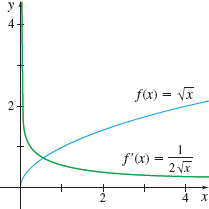EXAMPLE 2Finding the Derivative Function
Differentiate f(x)=√x and determine the domain of f′.
The instruction “differentiate f” means to “find the derivative of f.”
Solution The domain of f is {x|x≥0}. To find the derivative of f, we use form (3). Then f′(x)=lim
We rationalize the numerator to find the limit. \begin{eqnarray*} f^\prime ( x) &=&\lim\limits_{h\rightarrow 0}\left[ \dfrac{\sqrt{ x+h}-\sqrt{x}}{h}\cdot \dfrac{\sqrt{x+h}+\sqrt{x}}{\sqrt{x+h}+\sqrt{x} } \right] =\lim\limits_{h\rightarrow 0}\dfrac{( x+h) -x}{ h( \sqrt{x+h}+\sqrt{x}) } \\[5pt] &=&\lim\limits_{h\rightarrow 0}\dfrac{h}{h( \sqrt{x+h}+\sqrt{x}) } =\lim\limits_{h\rightarrow 0}\dfrac{1}{\sqrt{x+h}+\sqrt{x}}=\dfrac{1}{2\sqrt{ x}} \end{eqnarray*}
The limit does not exist when x=0. But for all other x in the domain of f, the limit does exist. So, the domain of the derivative function f^\prime (x) =\dfrac{1}{2\sqrt{x}} is \{ x|x>0\}.
